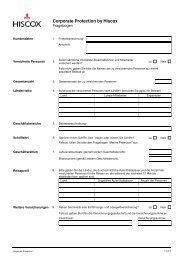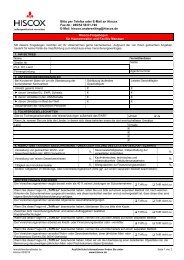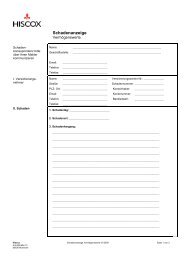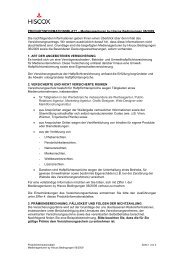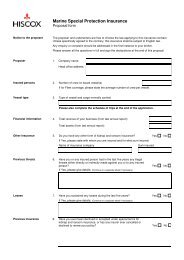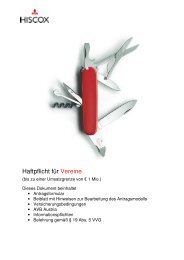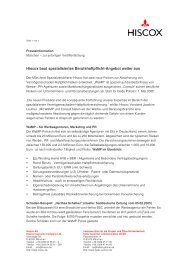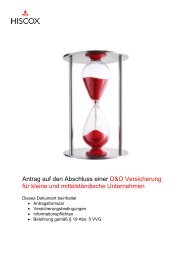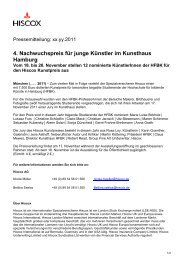Download PDF - Hiscox
Download PDF - Hiscox
Download PDF - Hiscox
Create successful ePaper yourself
Turn your PDF publications into a flip-book with our unique Google optimized e-Paper software.
3 Management of risk continued<br />
3.3 Capital risk management continued<br />
the Group. The Group maintains its cost<br />
of capital levels and its debt to overall<br />
equity ratios in line with others in the<br />
non-life insurance industry.<br />
Capital modelling and regulation<br />
The capital requirements of an insurance<br />
group are determined by its exposure to<br />
risk and the solvency criteria established<br />
by management and statutory regulations.<br />
In 2005, the UK Financial Services<br />
Authority (FSA) and Lloyd’s introduced a<br />
new capital regime that requires insurance<br />
companies to calculate their own capital<br />
requirements through Individual Capital<br />
Assessments (ICA). <strong>Hiscox</strong> Insurance<br />
Company Limited and Syndicate 33<br />
maintain ICA models in accordance with<br />
this regime. The models are concentrated<br />
specifically on the particular product lines,<br />
market conditions and risk appetite of each<br />
entity. If the FSA considers an ICA to be<br />
inadequate, it can require the entity to<br />
maintain an increased capital safeguard.<br />
The Directors are also required to certify<br />
that the Group has complied, in all material<br />
aspects, with the provisions of the Interim<br />
Prudential Sourcebook: Insurers (IPRU(INS)),<br />
the Integrated Prudential Sourcebook for<br />
Insurers (INSPRU) and General Prudential<br />
Sourcebook (GENPRU) when completing<br />
the ICA return. The Group used its own<br />
integrated modelling expertise to produce<br />
the ICA calculations. The results mirrored<br />
those driving the existing internal capital<br />
setting process.<br />
The Group’s capital requirements are<br />
managed both centrally and at a regulated<br />
entity level. The assessed capital requirement<br />
for the business placed through <strong>Hiscox</strong><br />
Insurance Company Limited, <strong>Hiscox</strong><br />
Insurance Company (Bermuda) Limited,<br />
<strong>Hiscox</strong> Insurance Company (Guernsey)<br />
Limited and <strong>Hiscox</strong> Insurance Company Inc.,<br />
is driven by the level of resources necessary<br />
to maintain both regulatory requirements<br />
and the capital necessary to maintain<br />
financial strength of an A rating.<br />
For Syndicate 33, the ICA process produces<br />
a result that is uplifted by Lloyd’s to identify<br />
the capital required to hold the A rating.<br />
The strong control and risk management<br />
environment, together with the sophistication<br />
of the modelling, have produced a capital<br />
ratio below that suggested under the<br />
previous risk-based capital regime.<br />
Another key area of capital modelling for<br />
<strong>Hiscox</strong> is to identify which insurance vehicle<br />
produces the best return on capital employed<br />
for the Group, given certain restraints from<br />
licences, reinsurance and the regulatory<br />
environment. This modelling takes into<br />
account transactional costs and tax, in<br />
addition to the necessary capital ratios.<br />
It proves the capital efficiency of Lloyd’s,<br />
despite a tax disadvantage against offshore<br />
entities, and the cost advantage of<br />
processing smaller premium business<br />
outside of Lloyd’s.<br />
In addition to the ICA modelling process,<br />
the EU Insurance Group’s Directive<br />
of 1998, as amended by the Financial<br />
Group’s Directive (FGD), compels insurance<br />
companies that are members of a group<br />
to consider the solvency margin of their<br />
ultimate parent company. This consideration<br />
must refer to the surplus assets of the<br />
ultimate parent’s related insurers, reinsurers,<br />
intermediate holding companies and other<br />
regulated entities.<br />
The FGD has been applied in the UK through<br />
INSPRU and GENPRU. In accordance with<br />
these provisions, the parent company’s<br />
solvency margin consideration became a<br />
minimum capital requirement for the Group<br />
from 31 December 2006 onwards. The<br />
Group complied with the requirement<br />
for the current and prior year.<br />
In the Group’s other geographical territories,<br />
including the US, its subsidiaries<br />
underwriting insurance business are<br />
required to operate within broadly similar<br />
risk-based externally imposed capital<br />
requirements when accepting business.<br />
4 Operating segments<br />
The Group’s operating segments consist<br />
of four segments which recognise the<br />
differences between products and services,<br />
customer groupings and geographical<br />
areas. Financial information is used in<br />
this format by the chief operating decision<br />
maker in deciding how to allocate<br />
resources and in assessing performance.<br />
The format is representative of the<br />
management structure of the segments.<br />
During the year, following a new geographic<br />
management structure including new<br />
business written through Syndicate 3624,<br />
the Group has changed its segmental<br />
reporting to provide more effective financial<br />
reporting for the evaluation of business<br />
segments by the chief operating decision<br />
maker to make decisions about future<br />
allocation of resources. Accordingly the<br />
2008 segmental comparatives have been<br />
restated in order to enable comparison<br />
of results by the user.<br />
The Group’s four operating segments are:<br />
London Market comprises the results<br />
of Syndicate 33, excluding the results<br />
of the fine art, UK regional events<br />
coverage and non US household<br />
business which is included within the<br />
results of UK and Europe. In addition,<br />
it excludes the larger TMT business<br />
which is allocated to the International<br />
segment and an element of kidnap<br />
and ransom and terrorism included<br />
in UK and Europe.<br />
UK and Europe comprises the results<br />
of <strong>Hiscox</strong> Insurance Company Limited,<br />
the results of Syndicate 33’s fine art,<br />
UK regional events coverage and non<br />
US household business, together with<br />
the income and expenses arising from<br />
the Group’s retail agency activities<br />
in the UK and in continental Europe.<br />
It excludes the results of the larger<br />
retail TMT business written by <strong>Hiscox</strong><br />
Insurance Company Limited. It also<br />
includes an element of kidnap and<br />
ransom and terrorism written in<br />
Syndicate 33.<br />
International comprises the results<br />
of <strong>Hiscox</strong> Insurance Company<br />
(Guernsey) Limited, <strong>Hiscox</strong> Insurance<br />
Company (Bermuda) Limited,<br />
Syndicate 3624, <strong>Hiscox</strong> Inc. and<br />
<strong>Hiscox</strong> Insurance Company Inc..<br />
It also includes the results of the<br />
larger TMT business written by<br />
<strong>Hiscox</strong> Insurance Company Limited<br />
and Syndicate 33.<br />
Corporate Centre comprises the<br />
investment return, finance costs and<br />
administrative costs associated<br />
with Group management activities.<br />
Corporate Centre also includes the<br />
majority of foreign currency items<br />
on economic hedges and intragroup<br />
borrowings. These relate to certain<br />
foreign currency items on economic<br />
hedges and intragroup borrowings,<br />
further details of which are given<br />
at note 14. Corporate Centre forms<br />
a reportable segment due to its<br />
investment activities which earn<br />
significant external coupon revenues.<br />
Notes to the consolidated financial statements <strong>Hiscox</strong> Ltd Report and Accounts 2009<br />
71




